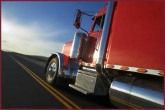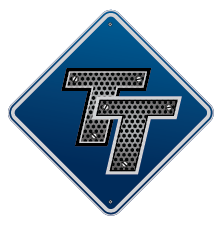First Incident
Topic 33652 | Page 1
I highly doubt they will send you packing after one incident, especially if you are a good employee.
Your boss will probably want to go over what you learned and how you plan on preventing it from happening again.
Chill, Alex.
Most companies pretty much expect you to have an incident in your first year. Sure, the boss will want to go over things with you. You may actually have to speak with someone form the Safety department. Your key here is to admit your fault (It sounds like you do here), that you learned more about blind side backing and you will Get Out And Look whenever you can't see what you're doing at the back end of the trailer.
In my first year I had maybe three reportable incidents. The first one, my trailer door got loose from the door tie and swung against the warehouse sheet metal wall while I pulled up in adjustment. I ripped a hole in the wall. On the way back to the terminal , I also felt like I should pack my stuff and look for another job. But the only thing that happened there was the conversation with the safety department.
Your company does keep track of even these small incidents. Yes, if you have too many, you will be considered a risk (I'll call it "driver sloppiness") and you may be let go.
Things to know: Remove "I thought" and "I assumed" from your mouth. Do not use those terms. Admit you did not get out and look as you should. Blind side alley dock is dangerous enough that you should do your best to approach it so you do sight side. If not, GOAL several times.
Terminal:
A facility where trucking companies operate out of, or their "home base" if you will. A lot of major companies have multiple terminals around the country which usually consist of the main office building, a drop lot for trailers, and sometimes a repair shop and wash facilities.
Dm:
Dispatcher, Fleet Manager, Driver Manager
The primary person a driver communicates with at his/her company. A dispatcher can play many roles, depending on the company's structure. Dispatchers may assign freight, file requests for home time, relay messages between the driver and management, inform customer service of any delays, change appointment times, and report information to the load planners.HOS:
Hours Of Service
HOS refers to the logbook hours of service regulations.OOS:
When a violation by either a driver or company is confirmed, an out-of-service order removes either the driver or the vehicle from the roadway until the violation is corrected.

Thanks to everyone for their replies! It means a lot.
Update: I bit the bullet and spoke with safety and my boss. They liked what they heard and gave me another chance. I was supposed to go through a training session with my boss but he didn't give it to me haha. I guess they trust me enough.
Prior to the call(s), I continued receiving loads. Good sign. I was sent to places that had even smaller yards than the one I had the accident in. I made sure to GOAL that time and had successful backs.
Now, I just need to learn how to survive winter driving. After going through training and watching several YouTube videos I know what I SHOULD be doing, but I won't know until I put it all into practice.
Quick question on that, though, I've heard people say only use level 1 Jakes in snow. Others say to not use it, but use downshifting. What am I actually supposed to do? ^_^'
Generally, you want to avoid using both cruise control and the jakes in slippery conditions. It’s all about your traction. If traction is not good, then drive slower and use the service brake.
Do you know the reason for not using the jakes in slippery conditions? It is important to know why. Using the jakes will only brake the tractor drive wheels, leaving the trailer & the load to push the tractor and can result in a jackknife.
As a rule of thumb in winter conditions, I try to use the minimum speed of the highway as an indicator. If the minimum posted speed is 40 mph and I can’t safely maintain 40 mph, then it’s probably time to get off the road and park until conditions improve. Give the road crews time to do their job before continuing.
I want to underline BK:
Do you know the reason for not using the jakes in slippery conditions? It is important to know why. Using the jakes will only brake the tractor drive wheels, leaving the trailer & the load to push the tractor and can result in a jackknife.
A jackknife is caused when there is an imbalance in traction between your steer, drive and tandem axles. (Traction is the force used between the tires and the road.) The Jake brakes only work on one set of axles. So if the drive axle wants to slow down and the other two don't, there you go!
Driving hints:
- Try to stay in the "used" lines where most tires have been. Simply changing lanes can be dangerous.
- Yes, bridge roadways will freeze before the "ground" does.
-
My personal technique for crossing super slick spots, like those bridges, is similar to throwing a ball: before you get on the slick stuff, look at your target, "aim" your truck at the other side and roll.
- Use the accelerator to keep the same speed.
- Do not touch the brake pedal at least till you get across.
- On the other side, breathe.
Tandem:
Tandem Axles
A set of axles spaced close together, legally defined as more than 40 and less than 96 inches apart by the USDOT. Drivers tend to refer to the tandem axles on their trailer as just "tandems". You might hear a driver say, "I'm 400 pounds overweight on my tandems", referring to his trailer tandems, not his tractor tandems. Tractor tandems are generally just referred to as "drives" which is short for "drive axles".
HOS:
Hours Of Service
HOS refers to the logbook hours of service regulations.OWI:
Operating While Intoxicated

So did you back into the light pole or ram it with your truck? Don't try to force your truck or trailer to move when you feel resistance during tight maneuvers. Move very slowly and feather the accelerator as well. You can avoid damaging somethings using those guidelines even if you back into them (such as bollards).
HOS:
Hours Of Service
HOS refers to the logbook hours of service regulations.
So did you back into the light pole or ram it with your truck? Don't try to force your truck or trailer to move when you feel resistance during tight maneuvers. Move very slowly and feather the accelerator as well. You can avoid damaging somethings using those guidelines even if you back into them (such as bollards).
Backing slowly and gently is a good practice. Just a cautionary note, no matter how slow and gently you back up, you will not be able to detect all resistance from contact with an object. This practice can never replace a good old GOAL.
Part of the reason it’s so hard to detect contact with certain objects has to do with the mass and weight of the tractor and trailer. Yes, you will feel the “bump” of a dock, but probably not feel anything when you destroy a light pole or fence post.
Shortly after I began driving, I was doing a super slow backing maneuver in a tight situation and knocked over a 10 foot tall commercial chain link fence post embedded in concrete. I had even done a GOAL and knew I had approximately 3 feet of space. Unfortunately, I backed up approximately 3 feet 1 inch and hit the post. I felt nothing from the contact. The only indication that I hit the metal post was the sickening sound of metal hitting the concrete driveway. That went down as a preventable accident on my record.
So never replace the tried and true practice of GOAL with any other method for backing.
HOS:
Hours Of Service
HOS refers to the logbook hours of service regulations.
I've backed into pine trees and bollards (the yellow poles) and I was able to sense the resistance. I was moving very slowly so I didn't damage them. Also, he said that he was going over a curb with his truck, which you should be able to detect if you're moving slowly. I wasn't disputing GOALing, that's a given and people had already discussed that on this post. I'm just saying that if you sense anything thing wrong, don't keep backing or turning as it can make things much worse.
So did you back into the light pole or ram it with your truck? Don't try to force your truck or trailer to move when you feel resistance during tight maneuvers. Move very slowly and feather the accelerator as well. You can avoid damaging somethings using those guidelines even if you back into them (such as bollards).
Backing slowly and gently is a good practice. Just a cautionary note, no matter how slow and gently you back up, you will not be able to detect all resistance from contact with an object. This practice can never replace a good old GOAL.
Part of the reason it’s so hard to detect contact with certain objects has to do with the mass and weight of the tractor and trailer. Yes, you will feel the “bump” of a dock, but probably not feel anything when you destroy a light pole or fence post.
Shortly after I began driving, I was doing a super slow backing maneuver in a tight situation and knocked over a 10 foot tall commercial chain link fence post embedded in concrete. I had even done a GOAL and knew I had approximately 3 feet of space. Unfortunately, I backed up approximately 3 feet 1 inch and hit the post. I felt nothing from the contact. The only indication that I hit the metal post was the sickening sound of metal hitting the concrete driveway. That went down as a preventable accident on my record.
So never replace the tried and true practice of GOAL with any other method for backing.
HOS:
Hours Of Service
HOS refers to the logbook hours of service regulations.New Reply:
New! Check out our help videos for a better understanding of our forum features

















Preview:








 TT On Facebook
TT On Facebook
Hi everyone,
I'm a new driver. I've been driving for about 4 months so far.
A couple days ago, I got into my first incident. I had a bad setup for reverse parking into a dock but thought I had enough room to continue around the curb line. I neglected to get out and look just to make sure... ended up hopping the curb with my steer tire and bumping into a light pole.
This was my first accident where I've ever been at fault and I feel absolutely embarrassed to make such a dumb mistake. I reported it to my company, but my nerves prevented me from telling the customer. My boss wants to see me about the incident in a couple days.
Since then, I've still been given assignments to complete and had no issues. I had one where the dock lot was even smaller than the one I was previously maneuvering in, and I made sure to GOAL that time to prevent a repeat mistake. Turns out, I needed to reset and give myself a bit more room to complete my maneuver, worked out perfectly.
My questions are: what exactly will my boss say to me in our meeting? How should I respond? Am I going to get fired? And how will this affect my driving record going forward?
I really like this job. I hope I don't get termed, but if I do, I guess it's deserved.